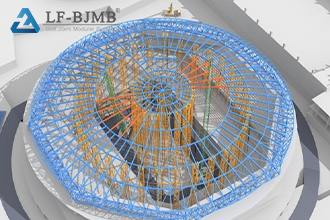In earthquake-prone areas, there are a variety of effective strategies that can be used in steel building design to minimize the damage caused by earthquakes. The following are some key strategies:

1.Reasonable building site selection: preference should be given to hard, dense and uniform site soils or dry, hard, open and flat site soils that are favorable for earthquake resistance for construction. At the same time, construction should be avoided on lots unfavorable to seismic resistance, such as liquefaction-prone soils, soft site soils, edges of slopes or river banks. Selection of such sites helps to minimize the impact of earthquakes on buildings.
2.Suitable foundation design: The foundation is the basis for supporting the building and should be integral and rigid. If the natural foundation does not meet the requirements, pile foundation or other foundation reinforcement measures can be used. The stability of the foundation is crucial to reduce the uneven settlement of the building and structural cracks in an earthquake.
3.Optimization of steel structure arrangement: The design of steel structure buildings should be as regular as possible to avoid complex structural forms. Steel structure has good plasticity and ductility and can withstand large deformation, so these characteristics should be fully utilized in the design. For particularly complex structures, anti-vibration joints can be considered in appropriate parts.
4.Rod enhancement and rigid reinforcement: The use of steel pipes, angles, beams and other steel to build a steel frame system can enhance the seismic capacity of the structure. In addition, by increasing the stiffness of the members, such as by means of suspension bracing and wall reinforcement, the stiffness of the overall structure can be further improved, thus enhancing the ability to withstand seismic forces.
5.Reducing building mass: By designing lightweight and small-area steel structural members, the structural mass can be reduced, thus reducing the seismic effect. This is an effective method to mitigate seismic hazards.
6.Application of seismic isolation measures: installing seismic isolation equipment, such as rubber mats or other seismic isolation devices, between the building foundation and the superstructure can absorb the energy of seismic waves and reduce the impact of earthquakes on the superstructure. This kind of seismic isolation technology can effectively reduce the damage of earthquakes to buildings.
7.Daily maintenance and overhaul: Although steel structure buildings have better seismic performance, daily maintenance and overhaul are still very important. The foundation anchorage, steel structure connection and other parts should be checked regularly to ensure that they are intact. At the same time, anti-corrosion and fire prevention of steel structure should also be emphasized.
In general, steel structure building design in earthquake-prone areas should focus on site selection, foundation design, structural optimization, rod enhancement, rigid reinforcement, mass reduction, application of seismic isolation measures, as well as routine maintenance and overhaul. By comprehensively considering these factors, the impact of earthquakes on steel structure buildings can be effectively reduced to protect people’s lives and properties.











 About Us
About Us 2024-03-08
2024-03-08


